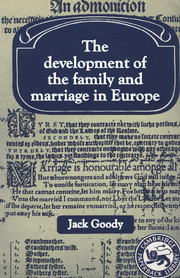Book contents
- Frontmatter
- Contents
- List of figures, maps and tables
- Preface
- 1 Perspectives
- 2 Two sides to the Mediterranean
- 3 Change in the German lands
- 4 Cousins and widows, adoptees and concubines
- 5 From sect to Church
- 6 Church, land and family in the West
- 7 Reformation and reform
- 8 The hidden economy of kinship
- 9 The spiritual and the natural
- Appendix 1 Kin groups: clans, lineages and lignages
- Appendix 2 From brideprice to dowry?
- Appendix 3 ‘Bilaterality’ and the development of English kin terminology
- References and bibliography
- Glossary
- Index
5 - From sect to Church
Published online by Cambridge University Press: 05 June 2012
- Frontmatter
- Contents
- List of figures, maps and tables
- Preface
- 1 Perspectives
- 2 Two sides to the Mediterranean
- 3 Change in the German lands
- 4 Cousins and widows, adoptees and concubines
- 5 From sect to Church
- 6 Church, land and family in the West
- 7 Reformation and reform
- 8 The hidden economy of kinship
- 9 The spiritual and the natural
- Appendix 1 Kin groups: clans, lineages and lignages
- Appendix 2 From brideprice to dowry?
- Appendix 3 ‘Bilaterality’ and the development of English kin terminology
- References and bibliography
- Glossary
- Index
Summary
The far-reaching changes in family structure that occurred in Europe were not due to the influence of Roman or Jewish law and custom. Nor were they the ones sometimes seen as peculiarly Christian. Many of the features that apologists associate with Christianity were already present, at least in embryo, in the contemporary patterns of marriage and the family in the Middle East, for example, those which stressed the conjugal family and the position of women as heirs. But there were also important changes, including those recorded by the Venerable Bede, which were not embodied in the teaching and practice of early Christianity. These new features did not emerge until the fourth century after Christ, by which time the Church had become established and an orthodox Christianity had arisen. This orthodoxy, by corollary, necessarily entailed the rise of heresy; for orthodoxy, according to Brown, was not a dogma but ‘an ecclesiastical vested interest’ (1972: 243), an interest that accompanied the development of the Church as an organisation with buildings, land, personnel and legitimacy. These features did not have much to do with the attitudes and doctrines examined in the accounts of ecclesiastical historians, except in the stress that they placed on the conjugal family (even in opposition to wider ties of kinship), on consensual unions (even in opposition to parental wishes), and on the role of women as holders of property.
- Type
- Chapter
- Information
- The Development of the Family and Marriage in Europe , pp. 83 - 102Publisher: Cambridge University PressPrint publication year: 1983
- 1
- Cited by

